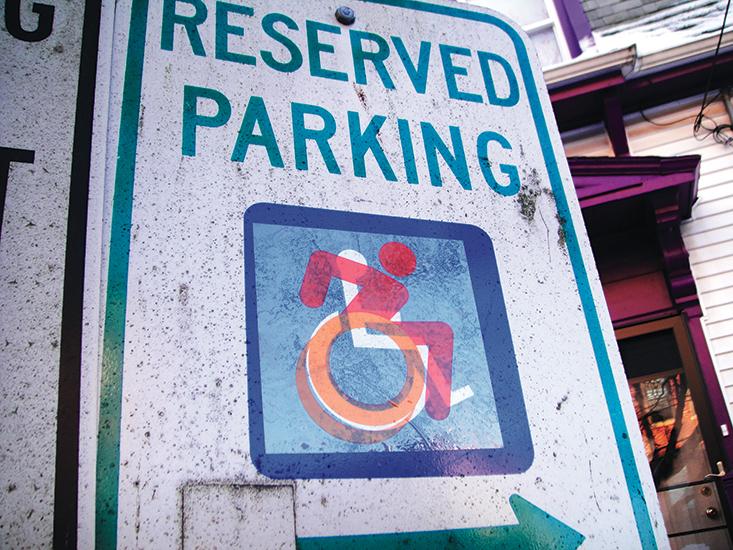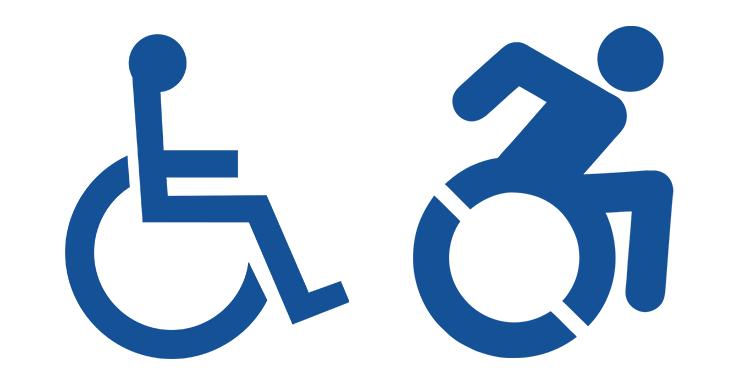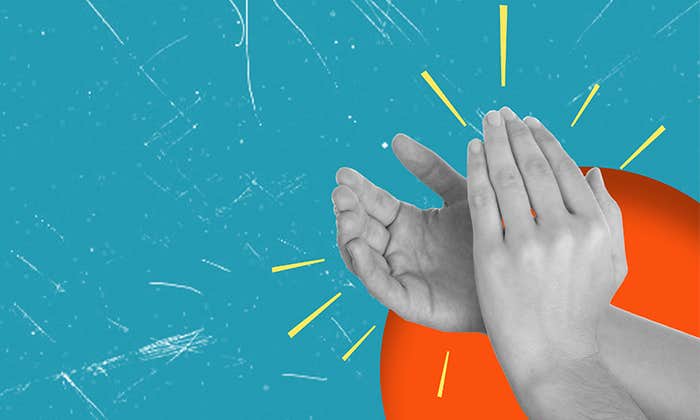In 2010, Sara Hendren began a guerrilla street art campaign. The assistant professor of design teamed with philosophy professor Brian Glenney to change the commonly accepted symbol for disability, called the International Symbol of Access. It shows a figure sitting in a wheelchair, on a blue background.
Hendren and Glenney thought the symbol made the chair look more important and visible than the person sitting on it. So they came up with their own version, in which the figure was leaning forward, elbows out, as if about to push off in some direction. The pair went around pasting a transparent sticker featuring their redesign over the old symbol in public places, so that people could see both old and new. Although the new symbol has not been formally adopted, it is being used by several educational institutions, private companies, and hospitals, and is part of the permanent collection at the Museum of Modern Art in New York City.
Hendren studied at Harvard’s Graduate School of Design, and, together with her students at Olin College in Massachusetts, makes assistive and adaptive technology for the disabled. But she is also interested in changing the cultural understanding of disability, pointing out that we are all on a spectrum of varying ability. “My projects awaken hidden or suppressed politics about ability, health, interdependence, and bodily normativity,” Hendren explains.
Nautilus caught up with Hendren this January.

How did you get interested in disability?
In my formative years, I thought of myself as somebody who was exclusively about books and words, and images and color, and metaphor and poetry, and all those kinds of things. I went to college in a little religious school outside of Chicago. I studied visual arts, painting, and drawing in Boston, and worked in education research. Then I started a Ph.D. in intellectual and cultural history at UCLA in 1999, got dissatisfied with history writing and history scholarship as it was performed then, and left it in 2003-04. Then, I did a bunch of freelance, stitched together a bunch of jobs, went back to painting, then figured out that public design language could also be critical and expressive. Then about 10 years ago, my son, my oldest of three children was born. He has Down syndrome. The politics of disability coupled with making things in design, and my training in cultural and intellectual history, all kind of came together in the decade following his birth. I went back to design school at Harvard in 2011, and joined Olin College in 2014.
Did your son’s condition change your views on the subject?
People who had been invisible to me were suddenly visible. My understanding of autism really morphed and changed. Really it’s about being a parent of somebody who is vulnerable in the existing culture and whose genetic mutation stands in for his entire identity. Once people know that about him, that’s kind of all they can see. So, now my life is full of people who are blind, who are deaf, autistic, and use wheelchairs, in ways I could never have imagined 10 years ago. His birth also woke me up to the material culture of artifacts and prosthetics and technologies. From the little braces he wore, to the glasses he got before he was a year old, to the therapeutic toys. I started to think about crutches and wheelchairs and hearing aids. What is the language of these things? What is their history and genealogy? A lot of those artifacts are medical, and from that association we get that patients are deformed. We see them as kind of medically broken. So, we have these tools to fix them and make them better.
What is disability for you?
I think disability is partly a medical identity, and partly a political identity. What our culture needs to hear, though, is how disability is a political identity, because we live in a time where disability exclusively exists on the body. Your legs don’t work, so therefore you are disabled. Actually, you are not disabled by your legs not walking, you are disabled by infrastructure and cities and towns that are built with stairs and without ramps. We are all aggregates of things that we do really well and things that we do really poorly. Peaks and valleys in our abilities and capacities. Maybe the things that we do well are the things that culture wants, and what we don’t do well are the things that culture doesn’t want us to do.
People act like engineering is going to rescue these bodies. Then what?
Do we misunderstand technology that assists the disabled?
When we talk about design technology in the context of disability, we call it assistive technology. But all technology is assistive. Curb cuts were thought to be an extreme user case for wheelchairs. But it turns out that they also make passage through a city easy for a lot of people, like children who are learning to walk, and people who are pushing strollers. Look at the use of elevators. People who are with young children, people who are injured, people who are with older adults who have trouble walking all use them. The Oxo brand of kitchen tools was designed by a man whose wife had arthritis in her hands. He made a fortune by figuring out that a lot of people need some of the same tools that she did. Disabilities occupy the continuum of normal human variation, and technology can do something similar. It’s not that there is technology for normal people, and there is assistive technology for not-normal people.

How can the stigma surrounding technology for the disabled be addressed?
There is no stigma attached to your eyes having less than 20-20 vision. People who wear eyeglasses do not feel any shame in walking out of the door. But studies show there is plenty of stigma attached to hearing aids. I want people to see technologies doing lots of things for lots of people. There are plenty of design speculations, like a hearing aid could not only control the volume of what you are hearing but also how much you are hearing of one thing in particular. How much you are hearing what is in front of you, while tuning out the rest. That can be quite useful in a noisy restaurant. I think there are lots of other opportunities like this to de-stigmatize.
What do you make of the wide publicity given to high-end gear for disabled people, like exoskeletons?
I love these exoskeletons. I am astonished at them as a feat of engineering and think we should celebrate them and support them. I also think that they monopolize the headlines about disability, about prosthetics, and about the promise of technology. We have 100 other kinds of stories about the ways people are living their lives. Lives that are worth living with artifacts and gears but also with systems, jobs, and supports that comes from lots of places. Some of them are low-tech, some of them are systems-scale, and some of them are architectural. A lot of them are hidden from you. The director of the Adaptive Design Association in New York City just won a MacArthur “Genius” award. They have been building adaptive furniture out of triple-walled cardboard for pennies, for decades, and they do it for free. Jaipur Foot in India is producing recycled rubber limbs. There is daily living advice on websites targeted for people living with muscular dystrophy. Ways to button a shirt on your own, ways to hold a fork in a steady manner. There are white canes. White canes are a smart technology. They have resisted many new market entrants. People who are blind find them incredibly elegant and useful tools. But they do not make newsworthy headlines.
Is cheap, scalable technology a necessity?
History shows that the availability of technology doesn’t actually make a more equitable world. In this country, after 25 years of working for rights for people with disabilities, we are still seeing high unemployment rates for the disabled. Look at what happens even in the best inclusive schooling situations. Disabled students who age out of the public school system, their prospects just tank. And this is the richest country in the world, with all kinds of assistive and adaptive technology products available. So you will never convince me that just the sheer production of products that can be scaled cheaply is going to change the way people think about people who have disabilities. You need people to change their minds. So, I am an unabashed culture producer. I think, does democracy come when the next five great products come to the market? History shows that is not the case. History shows that people change their minds based on a lot of things. Look at the way gay rights have been transformed in this country. Sitcoms starting in the ’90s had openly gay characters that went out on national networks, like Ellen. It would have been unheard of more than 25 years ago. So, I think there is a lot of tech-saviorism in the world around disability. People act like engineering is going to rescue these bodies. Then what? Are they going to get better jobs, or suddenly get the respect or the dignity that they are asking for? I strongly feel that engineering does some good things—and cultural forms and stories, objects and artifacts, symbols and metaphors also do things to change the world.
Ankur Paliwal is a journalist who writes on science, health, and the environment. He is currently based in New York.


























